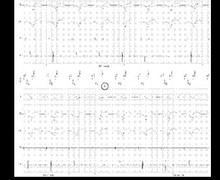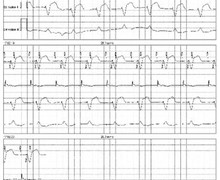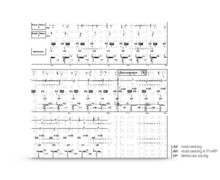Crosstalk and atrial undersensing
Tracing
Manufacturer Medtronic
Device CRT
Field Standard parameters
N° 16
Patient
65-year-old man, implanted with a triple-chamber defibrillator Concerto II CRT-D for valvular cardiomyopathy with left bundle branch block; crosstalk and adjustment of atrial sensitivity at 0.5 mV; interrogation of the device demonstrating ventricular sensed cycles.

Graph and trace
Ventricular sensed episode obtained during the initial interrogation of the device;
- crosstalk with cycles AS – BV – AR (the paced-ventricular activity is sensed by the atrial channel and falls in the PVARP);
- series of 6 consecutive VS cycles corresponding to an episode of atrial undersensing (no modification of the ventricular rate); loss of biventricular pacing;
Tracing recorded during the interrogation of the device - atrial sensing and biventricular pacing (AS-BV);
- atrial undersensing and ventricular sensing;
- crosstalk (AS-BV-AR cycles);
- long lasting episode of atrial undersensing with the absence of biventricular pacing
Other articles that may be of interest to you







This tracing illustrates the difficulty of adjusting atrial sensitivity in certain CRT patients with a sometimes very limited programming margin. This patient presented both a VA crosstalk (oversensing by the atrial channel of biventricular pacing) possibly justifying a decrease in atrial sensitivity and an average-quality sensing of atrial sinus activity requiring the programming of elevated sensitivity levels. The sensing test found an atrial amplitude measured at 0.8 mV at rest. As seen previously, the quality of atrial sensing can be further altered during exercise thus imposing an additional programming margin. Crosstalk was quasi permanent for a programmed atrial sensitivity of 0.5 mV. In this patient, the solution was probably not to attempt finding a compromise for the programming of atrial sensitivity (avoid crosstalk and preserve sensing) but to program a high sensitivity (0.3 mV) while attempting to prevent crosstalk by prolonging an absolute postventricular atrial blanking period or by programming the postventricular atrial blanking period on Partial + at the expense of a greater risk of not properly sensing a true episode of atrial arrhythmia.